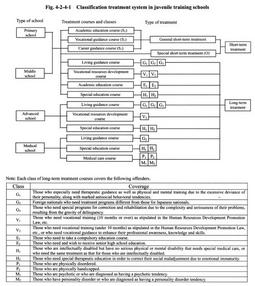| Previous Next Index Image Index Year Selection | |
|
|
1 Overview Juvenile training schools admit persons who are committed by family court under a protective measure and persons who are to serve a sentence at juvenile training schools under the provisions of the Juvenile Law (hereinafter referred to as the "convicted juveniles imprisoned in juvenile training schools"), and provide these juveniles with correctional education. As of April 1, 2003, there are 52 juvenile training schools as well as 1 branch school nationwide.
The term of detention for persons who are committed to juvenile training school under a protective measure is in principle the time until such persons reach 20 years of age under the current law. However, in the case that the period from commitment to the time when such persons become 20 years of age is less than 1 year, detention can be continued only within the 1 year from the adjudication of commitment. There are the following 4 types of juvenile training schools according to the age, the level of tendency to commit crime, and the physical and mental conditions of juvenile offenders admitted, and males and females are detained separately, except in medical schools. The various schools admit the following juveniles. [1] Primary schools (for juveniles aged 14 or over but generally under 16 without any serious physical or mental disorder): [2] Middle schools (for juveniles aged generally 16 or over but under 20 without any serious physical or mental disorder): [3] Advanced schools (for juveniles aged generally 16 or over but under 23 without any serious physical or mental disorder but with a strong tendency to commit crime; however, the convicted juveniles under 16 can be admitted as well); and [4] Medical schools (for juveniles aged 14 or over but under 26 with a serious physical or mental disorder). Out of such schools, treatment in primary schools and middle schools is classified into short-term treatment and long-term treatment. Short-term treatment is provided for juveniles whose correction and rehabilitation can be expected through continuous and intensive guidance and training for a short period, since the problems of the juveniles are simple or not so serious and fast improvement is likely to be seen in their behavior. Short-term treatment is divided into 2 types for operational purposes: general short-term treatment, the term of detention of which is 6 months at most, and special short-term treatment, which is provided for those who are less inclined to delinquency than those who are subject to general short-term treatment and are suitable for open treatment and the term of which is 4 months at most. Long-term treatment is provided for those who are not suitable for short-term treatment. The term of detention for long-term treatment is in principle 2 years at most. However, the term of detention shall be individually determined if it is deemed necessary to provide treatment for more than 2 years. For the term of detention, flexible operation is requested for correctional education of individual juvenile training school inmates and their smooth rehabilitation. For general short-term treatment and long-term treatment, the term of detention can be extended within the limit stipulated by the Juvenile Training School Law. General short-term treatment and long-term treatment are divided by the courses of treatment according to the educational needs of juveniles, and such courses are called treatment courses. There are 3 treatment courses in general short-term treatment, and 5 treatment courses in long-term treatment. Fig. 4-2-4-1 shows the classification treatment system in juvenile training schools. Fig. 4-2-4-1 Classification treatment system in juvenile training schools For commitment to a juvenile training school under protective measures, the type of school in which a juvenile is to be detained is decided through a hearing by a family court. In the hearing, a family court may recommend, in terms of type of treatment, that short-term treatment be provided for the juvenile in question.Juvenile classification homes designate the juvenile training school in which a juvenile who has received an adjudication of commitment to a juvenile training school is detained in line with the recommendation of treatment of the family court if such recommendation was made, or in consideration of the treatment courses implemented in each juvenile training school and the juvenile's treatment needs. The superintendents of juvenile training schools should issue an early discharge request to the relevant Regional Parole Board when they consider that the goal of correctional education for a juvenile has been attained. The superintendents should issue requests for release on parole to the relevant Regional Parole Board when they consider such measure to be appropriate due to the fact that a juvenile has improved to the highest level of treatment. Convicted juveniles imprisoned in juvenile training schools are provided with correctional education while living in separate quarters and classrooms, etc. from other juveniles until they turn 16. After that, they serve their sentence at penal institutions. |
